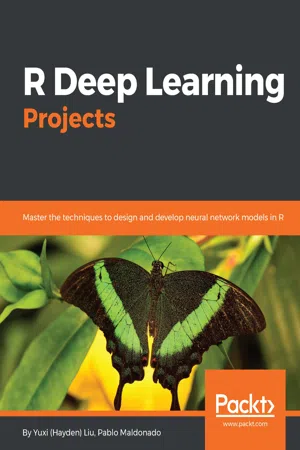
- English
- ePUB (mobile friendly)
- Available on iOS & Android
R Deep Learning Projects
About this book
5 real-world projects to help you master deep learning concepts
Key Features
- Master the different deep learning paradigms and build real-world projects related to text generation, sentiment analysis, fraud detection, and more
- Get to grips with R's impressive range of Deep Learning libraries and frameworks such as deepnet, MXNetR, Tensorflow, H2O, Keras, and text2vec
- Practical projects that show you how to implement different neural networks with helpful tips, tricks, and best practices
Book Description
R is a popular programming language used by statisticians and mathematicians for statistical analysis, and is popularly used for deep learning. Deep Learning, as we all know, is one of the trending topics today, and is finding practical applications in a lot of domains.
This book demonstrates end-to-end implementations of five real-world projects on popular topics in deep learning such as handwritten digit recognition, traffic light detection, fraud detection, text generation, and sentiment analysis. You'll learn how to train effective neural networks in R—including convolutional neural networks, recurrent neural networks, and LSTMs—and apply them in practical scenarios. The book also highlights how neural networks can be trained using GPU capabilities. You will use popular R libraries and packages—such as MXNetR, H2O, deepnet, and more—to implement the projects.
By the end of this book, you will have a better understanding of deep learning concepts and techniques and how to use them in a practical setting.
What you will learn
- Instrument Deep Learning models with packages such as deepnet, MXNetR, Tensorflow, H2O, Keras, and text2vec
- Apply neural networks to perform handwritten digit recognition using MXNet
- Get the knack of CNN models, Neural Network API, Keras, and TensorFlow for traffic sign classification -Implement credit card fraud detection with Autoencoders
- Master reconstructing images using variational autoencoders
- Wade through sentiment analysis from movie reviews
- Run from past to future and vice versa with bidirectional Long Short-Term Memory (LSTM) networks
- Understand the applications of Autoencoder Neural Networks in clustering and dimensionality reduction
Who this book is for
Machine learning professionals and data scientists looking to master deep learning by implementing practical projects in R will find this book a useful resource. A knowledge of R programming and the basic concepts of deep learning is required to get the best out of this book.
Frequently asked questions
- Essential is ideal for learners and professionals who enjoy exploring a wide range of subjects. Access the Essential Library with 800,000+ trusted titles and best-sellers across business, personal growth, and the humanities. Includes unlimited reading time and Standard Read Aloud voice.
- Complete: Perfect for advanced learners and researchers needing full, unrestricted access. Unlock 1.4M+ books across hundreds of subjects, including academic and specialized titles. The Complete Plan also includes advanced features like Premium Read Aloud and Research Assistant.
Please note we cannot support devices running on iOS 13 and Android 7 or earlier. Learn more about using the app.
Information
Text Generation Using Recurrent Neural Networks
- Sequence prediction: Given , predict the next element of the sequence,


- Sequence classification: Given , predict a category or label for it

- Sequence generation: Given , generate a new element of the sequence,


- Sequence to sequence prediction: Given , generate an equivalent sequence,


What is so exciting about recurrent neural networks?
- Produce consistent markup text (opening and closing tags, recognizing timestamp-like data)
- Write Wikipedia articles with references, and create URLs from non-existing addresses, by learning what a URL should look like
- Create credible-looking scientific papers from LaTeX
- One-to-one: Supervised learning, for instance, text classification
- One-to-many: Given an input text, generate a summary (a sequence of words with important information)
- Many-to-one: Sentiment analysis in text
- Many-to-many: Machine translation
But what is a recurrent neural network, really?
Table of contents
- Title Page
- Copyright and Credits
- Packt Upsell
- Contributors
- Preface
- Handwritten Digit Recognition Using Convolutional Neural Networks
- Traffic Sign Recognition for Intelligent Vehicles
- Fraud Detection with Autoencoders
- Text Generation Using Recurrent Neural Networks
- Sentiment Analysis with Word Embeddings
- Other Books You May Enjoy